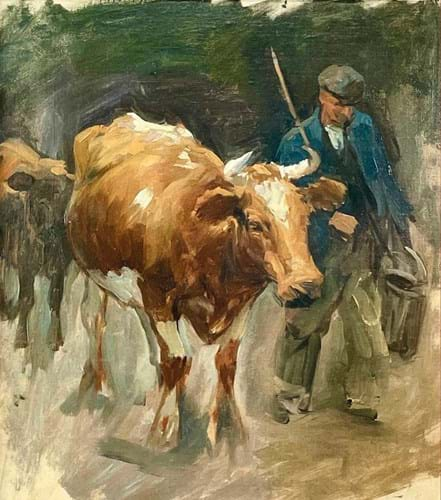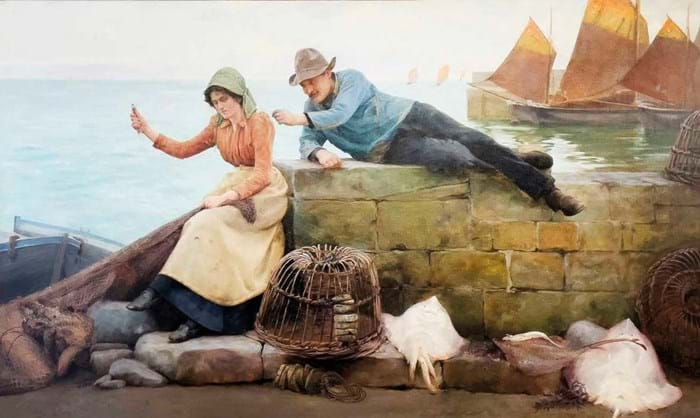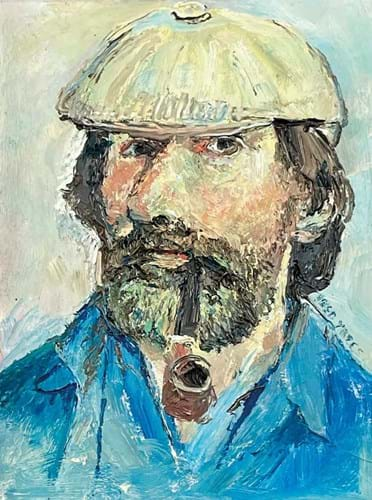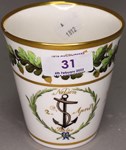Works by the first wave of Newlyn School artists created a string of headlines and high prices back in the 1980s-90s, but the market has had to readjust to deal with issues of both supply and demand.
On the demand side, buyers’ tastes have moved away somewhat from pre-First World War works with a shift towards pictures from later in the 20th century. When it comes to supply, important pictures by artists such as Stanhope Forbes (1857- 1947), Frank Bramley (1857-1915) and Walter Langley (1852-1922) have become scarcer over the last 20 years, with many now held in museums or well established private collections.
Having been over four years since a major Newlyn School painting came to auction, it was understandable that one that emerged at the latest David Lay (18% buyer’s premium) sale in Penzance attracted considerable attention.
As featured on the front page of ATG No 2530, Forbes’ Soldiers and Sailors, an impressively scaled Royal Academy exhibit showing a crowd of figures on a harbour, was estimated at £120,000-180,000 and sold at £155,000.
While it drew three bidders and sold to dealer David Messum safely within estimate, some people might have expected it to make more. “It’s a very important work, but I didn’t think I’d be able to buy it,” Messum told ATG.
It is difficult to gauge whether it was market factors or the condition of the work that held more sway. The picture had undergone restoration due to it being rolled up (presumably for safekeeping during the Blitz) and not all parties were convinced as to how well it would clean and restore now. Condition, of course, is as vitally important when it comes to Victorian pictures as with other sectors.
While it was undoubtedly a significant work painted during a key period by the ‘father’ of the Newlyn School (the over-used term ‘museum-quality’ may rightly be applied here), art historical importance and financial value are not always completely entwined in the Victorian art market.
Inevitably the market tends to favour sunnier scenes, ideally with fishermen and their boats (A Fish Sale on a Cornish Beach from 1884-5 is arguably Forbes’ most celebrated work), whereas this picture depicted a group of Salvation Army singers on a somewhat grey day.
Two further works by the artist in the David Lay sale came from different sources and also tested the market but again underlined these commercial realities.
Bringing In The Herd reflected the range of other subjects Forbes depicted as he aimed to show the ‘honest endeavour’ of local life in Cornwall such as farms, blacksmiths and other industries and interiors.
The 21¾ x 19¾in (55.5 x 50cm) oil on canvas laid on board here was a study probably for a larger agricultural scene. It came to auction from a local private client and the condition was relatively good with only some minor restoration required (it had one tiny area of retouching and some yellow varnish).
With its value probably limited by its subject matter and the fact that the lower section was left a bit unfinished, it had previously appeared at a Phillips sale in London back in 1987 where it was seemingly unsold against a £7000-9000 estimate.
Here it was pitched at £8000- 12,000 and performed relatively well by comparison, selling at £13,500 to a private buyer who was new to the saleroom and who registered as a phone bidder barely minutes before the auction started.

A study for Forbes’ mural The Destruction of the Second Royal Exchange in 1838. It sold for £5800 at David Lay.
The other work at David Lay was also a study for a larger painting and represented yet another side of the Forbes canon. The 3ft 8in x 2ft 7in (1.11m x 78cm) signed oil on canvas was a study for Forbes’ largest public commission – two murals he painted for the Royal Exchange in London.
They were completed as part of the regeneration programme between 1895-1927 when a series of around 30 striking panels depicting scenes from London’s history by different artists were installed on the building’s mezzanine (they have since been described as the city’s best-kept secret).
Forbes’ initial contribution was a depiction of the 1666 Great Fire of London – he completed the mural in 1899. His second panel was unveiled much later in 1921 and was titled The Destruction of the Second Royal Exchange in 1838. The premises burnt down in January of that year but had been reconstructed by the late 19th century.
The work at David Lay was a study of the figures to the lower left of the latter mural. Signed and dated 1920, it showed a mother and two children who were among the locals gathering to watch the spectacle of the building burning during the height of the fire. It came to auction from a collector of Newlyn School works and was described as ‘in excellent restored and lined condition’.
Despite being a well-handled study which closely relates to the finished work, again its value may have been limited as its appeal was probably more academic than commercial.
Estimated at £6000-8000, it sold at £5800 to the same buyer as Bringing In The Herd.
Art and Craft
Another Newlyn painting selling a bit under estimate was A Tiff by Percy Robert Craft (1856-1934).
The artist, who was also a professional actor and arts administrator (he was director of the Newlyn artists’ informal dramatic society), lodged with Forbes in the early 1880s and showed his works alongside his better-known contemporary as well as the likes of Walter Langley and Thomas Cooper Gotch (1854–1931).
This appears to be one of his major works. According to a note in The Cornishman in 1898, the 2ft 8in x 4ft 6in (82cm x 1.36m) signed oil on canvas was exhibited at the ‘Newlyn Showday’, the annual exhibition of works intended for the Royal Academy.
It came to auction from a dealer and was estimated at £15,000- 20,000, a level that looked a bit punchy as, according to Artprice, the highest price recorded for the artist at auction stands at £15,000 for The New Song at WH Lane back in 2002.
However, the fact that it was a large and colourful picture with an interesting subject, especially the interplay between the characters and the ray fish appearing in the foreground, stood in its favour. The auction house pointed out that the work may have even contained an element of humour, something rarely seen in the artist’s ouevre or indeed other in Newlyn School works.
Knocked down at £14,000 to a private client bidding online, the sum fetched was seemingly the second highest for the artist at auction.
Outside the Newlyn pictures, a self-portrait by Fred Yates (1922- 2008) attracted interest against a £1000-1500 estimate. The artist appears regularly at auction, most often his colourful Lowry-esque urban and coastal scenes, and works often emerge in the south-west as the Manchester artist moved down to Cornwall in 1969 when he took up painting full time.
While Yates painted dozens of self-portraits, they are less commonly seen on the secondary market and this example was deemed one of his better attempts. The 10½ x 8in (27 x 20cm) signed oil on board came to auction from a private West Country client having been through another local auction house back in 2009 (the price was not disclosed).
Here it brought a decent competition and sold at £2000 to a Penzance buyer who, the saleroom believed, may have known the artist himself.

















